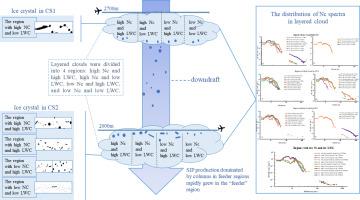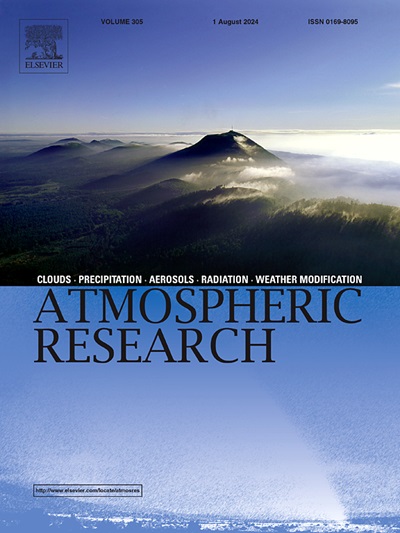飞机对中国华北平原上空气溶胶和混合相云微物理的观测:两层云的垂直分布、大小分布和云种子的影响
IF 4.5
2区 地球科学
Q1 METEOROLOGY & ATMOSPHERIC SCIENCES
引用次数: 0
摘要
气溶胶和云对气候影响至关重要。基于 2020 年 11 月 21 日在中国石家庄混合相云中的飞机观测,分析了云滴和冰晶颗粒的垂直分布和大小分布,以及云播种后类似于 "播种者-播种者 "过程对云微物理的影响。第一播种云(CS1)和第二播种云(CS2)分别位于 2600-2800 米和 1500-2300 米处。播种前,通过垂直观测,CS1 和 CS2 云滴的平均数量浓度(Nc)分别为 236.91 cm-3 和 152.13 cm-3。在 CS1 中,冰晶的平均数量浓度(Ni)为 0.26 L-1,包括树枝状冰晶和粒状冰晶;而在 CS2 中,冰晶的平均数量浓度(Ni)为 0.19 L-1,包括边缘板状冰晶、粒状冰晶和针状冰晶。播种后,CS1 的平均 Nc 从 322.90 cm-3 降至 260.69 cm-3,Nc 的光谱从 2.5 μm 扩展到 24 μm 至 45 μm。冰微物理在层状云中也有不同的反应。在 CS1 中,高 Nc 和低 LWC(Nc > 322.90 cm-3,LWC < 0.14 g∙m-3)区域的 Ni 增加了 421 倍,包括辐合冰晶、重边缘冰晶和灰凝胶(200-500 μm)。在 CS2 中,最大 Ni 值为 252.03 L-1,平均 Ni 值增加了 2 倍(从 0.39 升至 11.44 L-1)。在高 Nc 和高 LWC 区域(Nc > 92.78 cm-3, LWC > 0.13 g∙m-3)以及高 Nc 和低 LWC 区域(Nc > 92.78 cm-3, LWC < 0.13 g∙m-3),出现了边缘针状和柱状冰晶(200-300 μm)。CS1 和 CS2 中的播种形成了类似于 "播种机-喂入器 "过程的结构。在下沉气流(1 m/s)的控制下,这些颗粒降落到 CS2 的 "喂料机 "区域。适当的温度和有边缘的晶体促进了二次冰晶生成(SIP),从而在 CS2 中观察到了主冰柱(200-300 μm)。馈源 "区域比 "播种 "区域产生更多的冰晶。本文章由计算机程序翻译,如有差异,请以英文原文为准。

Aircraft observation of aerosol and mixed-phase cloud microphysical over the North China Plain, China: Vertical distribution, size distribution, and effects of cloud seeding in two-layered clouds
Aerosol and clouds are essential to climate effects. Based on an aircraft observation in a mixed-phase cloud in Shijiazhuang, China, on November 21, 2020, analyzing the vertical and size distributions of cloud droplets, and ice crystal particles, and the effects of the similar to a “seeder-feeder” process after cloud seeding on cloud microphysics. The first seeding cloud (CS1) and second seeding cloud (CS2) were at 2600–2800 m and 1500–2300 m, respectively. Before seeding, the average number concentration of cloud droplets (Nc) was 236.91 cm−3 and 152.13 cm−3 in CS1 and CS2 from vertical observation. In CS1, the average number concentration of ice crystals (Ni) was 0.26 L−1 with dendritic ice crystals and graupel, while in CS2, the average Ni was 0.19 L−1, including rimed plate ice crystals, graupel, and needle ice crystals. After seeding, the average Nc decreased from 322.90 to 260.69 cm−3 and the spectrum of Nc broadened from 2.5 to 24 to 45 μm in CS1. The ice microphysics also had different responses in the layered cloud. Ni increased by 421 times in regions with high Nc and low LWC (Nc > 322.90 cm−3, LWC < 0.14 g∙m−3), including spoked and heavily rimed ice crystals and graupel (200–500 μm) in CS1. In CS2, the maximum Ni was 252.03 L−1 and the average Ni increased by 2 magnitudes (from 0.39 to 11.44 L−1). There were rimed needles and columnar ice crystals (200–300 μm) in regions with high Nc and high LWC (Nc > 92.78 cm−3, LWC > 0.13 g∙m−3), and high Nc and low LWC (Nc > 92.78 cm−3, LWC < 0.13 g∙m−3). Seeding in CS1 and CS2 formed a structure similar to the “seeder-feeder” process. Controlled by the downdraft (>1 m/s), these particles descended into the “feeder” region of CS2. Appropriate temperature and rimed crystals contributed to secondary ice crystal production (SIP), resulting in main columns (200–300 μm) observed in CS2. The “feeder” region generated more ice crystals than the “seeder” region.
求助全文
通过发布文献求助,成功后即可免费获取论文全文。
去求助
来源期刊

Atmospheric Research
地学-气象与大气科学
CiteScore
9.40
自引率
10.90%
发文量
460
审稿时长
47 days
期刊介绍:
The journal publishes scientific papers (research papers, review articles, letters and notes) dealing with the part of the atmosphere where meteorological events occur. Attention is given to all processes extending from the earth surface to the tropopause, but special emphasis continues to be devoted to the physics of clouds, mesoscale meteorology and air pollution, i.e. atmospheric aerosols; microphysical processes; cloud dynamics and thermodynamics; numerical simulation, climatology, climate change and weather modification.
 求助内容:
求助内容: 应助结果提醒方式:
应助结果提醒方式:


